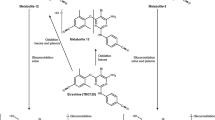Abstract.
Objective: To determine the pharmacokinetic profiles of atovaquone (ATO), proguanil (PROG) and its active metabolite cycloguanil (CYCLO) with respect to possible accumulation and kinetic interaction upon repeated dosing with Malarone. Methods: Thirteen healthy volunteers first received a single dose and then after 1 week, repetitive daily doses of Malarone (one tablet) for 13 days. For analysis of plasma drug concentrations, blood samples were collected at regular intervals over 8 days after a single dose and over 12 days after the last day of multiple dosing. Single-dose and steady-state pharmacokinetic parameters were determined for each individual. Genotyping of the gene coding for CYP2C19, a major enzyme catalyzing PROG metabolism, was performed using polymerase chain reaction, and in vitro enzyme kinetic experiments were carried out to study the possible effect of ATO on the catalytic activities of CYP2C19 and 3A4 using fluorometric assays. Results: For ATO, the ratio of the area under the concentration–time curve (AUC) during the last dose interval to the AUC after the single dose (AUC0– τ/AUC0– ∞) was found to be 0.90 [95% confidence interval (CI) 0.56, 1.24] indicating absence of undue accumulation. AUC0– τ, and peak plasma concentration at steady state (Cmax,ss) values were, however, threefold lower than those reported in human immunodeficiency virus-infected subjects after 12 multiple daily doses of 250 mg ATO alone. Four volunteers, with mean CYCLO/PROG AUC0– τ of 0.03 (–0.23, 0.09) were classified as poor metaboliser (PM) phenotypes. There was a significant increase in the AUC of PROG at steady state with a PROG AUC0– τ/AUC0– ∞ ratio of 1.38 (1.07, 1.69) in extensive metaboliser (EM) phenotypes. CYCLO/PROG AUC ratios were significantly lower 0.67 (0.54, 0.81) at steady state than that after the first single dose in EM phenotypes. The in vitro kinetic experiments on recombinant enzymes (CYP2C19 and CYP3A4) suggested a possible inhibition of catalytic activity of CYP3A4 by ATO. Conclusions: There was no unexpected accumulation of ATO following repeated administrations of the combination. In EM phenotypes, PROG elimination was reduced at steady state. Also, at steady state, either the elimination of CYCLO was increased or its formation clearance decreased the latter possibly by inhibition of CYP3A4 by ATO.
Similar content being viewed by others
Author information
Authors and Affiliations
Additional information
Accepted in revised form: 18 December 2001
Electronic Publication
Rights and permissions
About this article
Cite this article
Thapar, M.M., Ashton, M., Lindegårdh, N. et al. Time-dependent pharmacokinetics and drug metabolism of atovaquone plus proguanil (Malarone) when taken as chemoprophylaxis. Eur J Clin Pharmacol 58, 19–27 (2002). https://doi.org/10.1007/s00228-002-0426-9
Received:
Published:
Issue Date:
DOI: https://doi.org/10.1007/s00228-002-0426-9




